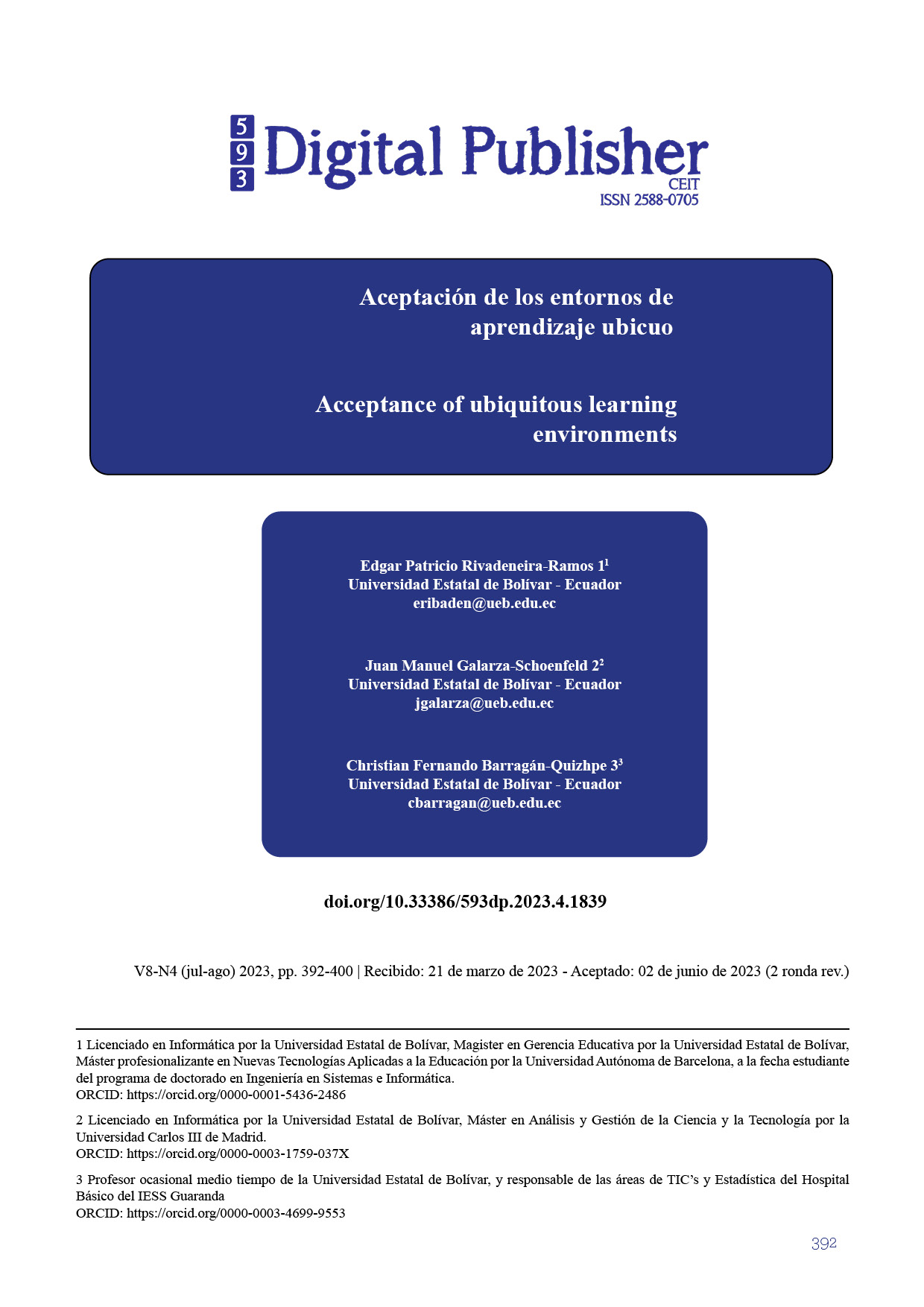Aceptación de los entornos de aprendizaje ubicuo
Contenido principal del artículo
Resumen
Este artículo tiene como propósito hacer una análisis de las características de las plataformas de educación ubicua en el sistema de educación superior para luego tratar de realizar una medición del nivel de aceptación de ese tipo de entornos tecnológicos en contextos reales. Para esto se plantea como pregunta de investigación ¿Cuál es el grado de aceptación de un entorno de aprendizaje ubicuo en los actores de instituciones de educación superior?, metodológicamente se busca, analizan y seleccionan varios artículos para establecer la base teórica y otros tantos para un estudio estadístico, basados en resultados de trabajos experimentales y tratar de contestar empíricamente a la pregunta planteada, para esto se trabaja un meta-análisis de los resultados de siete artículos que cumplen con los requerimientos establecidos; este trabajo concluye en que se hace necesario ampliar las condiciones empíricas para lograr resultados convincentes sobre el nivel de aceptación de los entornos ubicuos de aprendizaje, todo esto, más allá del hecho de que la literatura revisada siempre valide la necesidad de utilizarlos.
Descargas
Detalles del artículo

Esta obra está bajo una licencia internacional Creative Commons Atribución-NoComercial-CompartirIgual 4.0.
1. Derechos de autor
Las obras que se publican en 593 Digital Publisher CEIT están sujetas a los siguientes términos:
1.1. 593 Digital Publisher CEIT, conserva los derechos patrimoniales (copyright) de las obras publicadas, favorece y permite la reutilización de las mismas bajo la licencia Licencia Creative Commons 4.0 de Reconocimiento-NoComercial-CompartirIgual 4.0, por lo cual se pueden copiar, usar, difundir, transmitir y exponer públicamente, siempre que:
1.1.a. Se cite la autoría y fuente original de su publicación (revista, editorial, URL).
1.1.b. No se usen para fines comerciales u onerosos.
1.1.c. Se mencione la existencia y especificaciones de esta licencia de uso.
Citas
Atif, Y., & Zhang, L. (2014). Network resource management in support of QoS in ubiquitous learning. Journal of Network and Computer Applications, 41(1), 148–156. https://doi.org/10.1016/j.jnca.2013.11.003
Báez Pérez, C. I., & Clunie Beaufond, C. E. (2019). Una mirada a la Educación Ubicua.
Bolaños, R., & Calderón, M. (2014). Introducción al meta-análisis tradicional. Gastroenterol Perú, 34(1), 45–51.
Brouns, F., Teixeira, A., Morgado, L., Fano, S., Fueyo, A., & Jansen, D. (2016). Designing massive open online learning processes: The sMOOC pedagogical framework. Lecture Notes in Educational Technology, 9783662529232, 315–336. https://doi.org/10.1007/978-3-662-52925-6_16
Cárdenas-Robledo, L. A., & Peña-Ayala, A. (2018). Ubiquitous learning: A systematic review. Telematics and Informatics, 35(5), 1097–1132. https://doi.org/10.1016/j.tele.2018.01.009
Chen, G. D., Chang, C. K., & Wang, C. Y. (2008). Ubiquitous learning website: Scaffold learners by mobile devices with information-aware techniques. Computers and Education, 50(1), 77–90. https://doi.org/10.1016/j.compedu.2006.03.004
El-Sofany, H. F., & El-Seoud, S. A. (2022). Implementing effective learning with ubiquitous learning technology during coronavirus pandemic. Computer Systems Science and Engineering, 40(1), 389–404. https://doi.org/10.32604/CSSE.2022.018619
Garcia, L., Gonçalves, N., Francisco, R., Victória, J. L., Silva, L., & Quietinho, V. (2021). Ulearnenglish: An open ubiquitous system for assisting in learning english vocabulary. Electronics (Switzerland), 10(14), 1–14. https://doi.org/10.3390/electronics10141692
Kadek Suartama, I., Setyosari, P., Sulthoni, & Ulfa, S. (2021). Development of Learning Analytics Dashboard based on Moodle Learning Management System. International Journal of Advanced Computer Science and Applications, 12(7), 838–843. https://doi.org/10.14569/IJACSA.2021.0120793
Martin, S., Diaz, G., Plaza, I., Ruiz, E., Castro, M., & Peire, J. (2011). State of the art of frameworks and middleware for facilitating mobile and ubiquitous learning development. Journal of Systems and Software, 84(11), 1883–1891. https://doi.org/10.1016/j.jss.2011.06.042
Martínez-Rodríguez, R., & Benítez-Corona, L. (2020). La ecología del aprendizaje resiliente en ambientes ubicuos ante situaciones adversas. Comunicar, 28(62), 43–52. https://www.revistacomunicar.com/ojs/index.php/comunicar/article/view/C62-2020-04
Moreno, G. (2020). Modelo de U - learning basado en plataformas de TV everywhere Modelo de U - learning basado en plataformas de TV everywhere.
Mykytiuk, S., Lysytska, O., Melnikova, T., & Mykytiuk, S. (2022). Facebook as a Flexible Ubiquitous Learning Space for Developing Speaking Skills. IAFOR Journal of Education, 10(1), 109–133. https://doi.org/10.22492/ije.10.1.06
Parra-González, M. E., Belmonte, J. L., Segura-Robles, A., & Cabrera, A. F. (2020). Active and emerging methodologies for ubiquitous education: Potentials of flipped learning and gamification. Sustainability (Switzerland), 12(2). https://doi.org/10.3390/su12020602
Peña-Ayala, A. (2021). A learning design cooperative framework to instill 21st century education. Telematics and Informatics, 62(June 2020), 1–16. https://doi.org/10.1016/j.tele.2021.101632
Purba, S. W. D., & Hwang, W. Y. (2018). Investigation of learning behaviors and achievement of simple pendulum for vocational high school students with Ubiquitous-Physics app. Eurasia Journal of Mathematics, Science and Technology Education, 14(7), 2877–2893. https://doi.org/10.29333/ejmste/90985
Suartama, I. K., Sulthoni, Ulfa, S., Setyosari, P., Yunus, M., & Sugiani, K. A. (2021). Ubiquitous Learning vs. Electronic Learning: A Comparative Study on Learning Activeness and Learning Achievement of Students with Different Self-Regulated Learning. International Journal of Emerging Technologies in Learning, 16(3), 36–56. https://doi.org/10.3991/ijet.v16i03.14953
Wagner, A., Barbosa, J. L. V., & Barbosa, D. N. F. (2014). A model for profile management applied to ubiquitous learning environments. Expert Systems with Applications, 41(4 PART 2), 2023–2034. https://doi.org/10.1016/j.eswa.2013.08.098
Weiser, M. (1991). The Computer for the 21st Century - Specialized elements of hardware and software, connected by wires, radio waves and infrared, will be so ubiquitous that no one will notice their presence. In Readings in Human–Computer Interaction (pp. 933–940).
Yuen, S. C.-Y., Yaoyuneyong, G., & Johnson, E. (2011). Augmented Reality: An Overview and Five Directions for AR in Education. Journal of Educational Technology Development and Exchange, 4(1). https://doi.org/10.18785/jetde.0401.10




